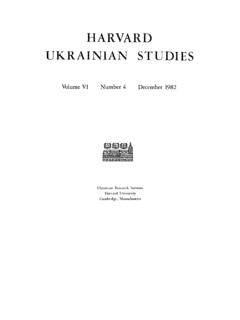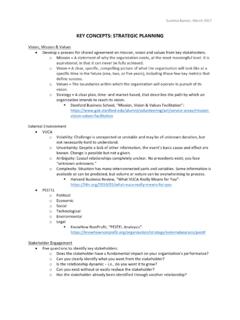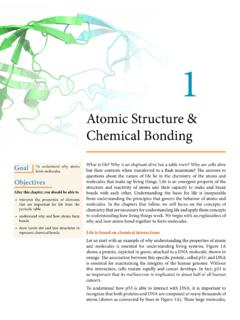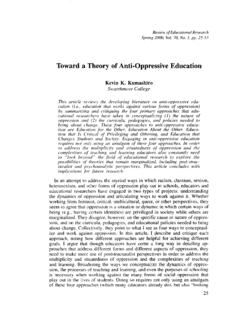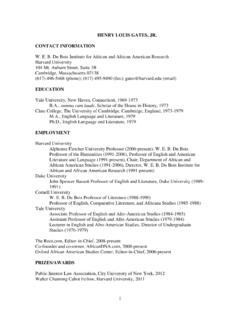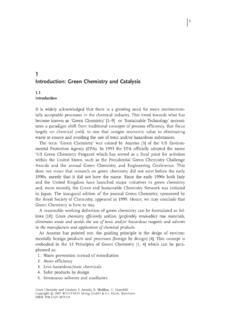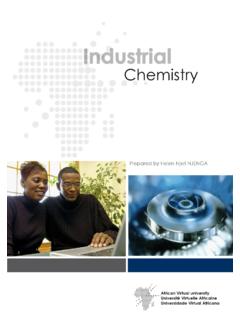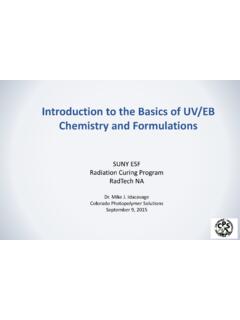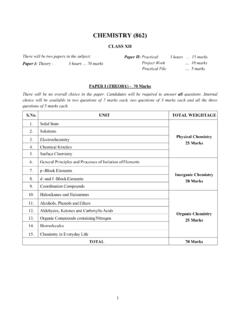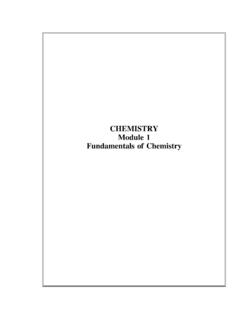Transcription of INTRODUCTION TO ATMOSPHERIC CHEMISTRY
1 1. INTRODUCTION TO ATMOSPHERIC CHEMISTRY : SUPPLEMENTAL QUESTIONS AND PROBLEMS. 12th EDITION. by Daniel J. Jacob Harvard University August 2021. FOREWORD. The questions and problems presented here are intended to supplement my book INTRODUCTION to ATMOSPHERIC CHEMISTRY (Princeton University Press, 1999). They are arranged following the different chapters of the book. In recent years I have added course segments on aerosol CHEMISTRY and on mercury. I have included problems to support these course segments. All problems are from recent exams in my course. This 12th edition includes several new problems and questions, and a few corrections to the previous edition. The problems are aimed at the advanced undergraduate and beginning graduate level.
2 They try to tell interesting, realistic, and sometimes surprising stories, often addressing current research problems and drawing from recent literature. They all lend themselves to simple analytical solutions, with minimum computation. Although this limits the scope of the problems, I believe that it enhances their value for building intuition and promoting understanding of processes, and it trains students in the important art of doing back-of-the-envelope calculations. It also reveals the beauty of ATMOSPHERIC CHEMISTRY , as the essence behind complicated real-world problems can often be found in simple relationships. I hope that you will find this as aesthetically pleasing as I do. Complete solutions are available to instructors.
3 To obtain the solutions, send me an email certifying your instructor status. Reference to a university department website is generally sufficient. I want to thank Colette Heald (MIT), Randall Martin (Dalhousie), Gabriele Curci (U. L'Aquila), Amos Tai (CUHK), Jennifer Murphy (U. Toronto), Arlene Fiore (Columbia), Dylan Millet (U. Minnesota) for catching errors in previous editions. If you find any other errors or ambiguities please let me know. I very much hope that you will enjoy working through these problems and that you will find them interesting and useful. Daniel J. Jacob Harvard University August 2021. Daniel J. Jacob, Supplemental Problems for INTRODUCTION to ATMOSPHERIC CHEMISTRY , 12th edition, 2021. Copyright by Daniel J.
4 Jacob, All Rights Reserved 2. TABLE OF CONTENTS. CHAPTER 1: MEASURES OF ATMOSPHERIC 5. 1. Short questions .. 5. 2. Seeing your breath .. 5. 3. Wet and dry mixing ratios .. 6. CHAPTER 2: ATMOSPHERIC 8. 1. Short questions .. 8. 2. Measuring aerosol concentrations .. 8. 3. The Venusian atmosphere .. 8. 4. Gravitational separation of air .. 9. 5. An oxygen source in the Archean atmosphere .. 9. CHAPTER 3: SIMPLE MODELS .. 11. 1. Short questions .. 11. 2. ATMOSPHERIC helium .. 11. 3. Observing the net US source of CO2 .. 12. 4. Verifying emission 12. 5. Aerosol scavenging by precipitation .. 13. 6. Ventilation of the eastern 13. 7. Using hydrocarbon pairs to infer OH concentrations .. 14. 8. Fossil fuel combustion as a source of water vapor.
5 14. 9. Inferring ATMOSPHERIC lifetimes from observed seasonal variations .. 15. 10. Beryllium isotopes as tracers of vertical transport .. 16. 11. ATMOSPHERIC titration.. 16. 12. Exchange between the troposphere and the mesosphere .. 17. 13. Observing methane emission from space .. 18. 14. Growth of ATMOSPHERIC 18. CHAPTER 4: ATMOSPHERIC TRANSPORT .. 20. 1. Short questions .. 20. 2. Cloud base altitude .. 21. 3. An atmosphere with fixed relative humidity? .. 21. 4. Scavenging in a convective updraft .. 21. 5. Fumigation .. 22. 6. Intercontinental transport .. 23. CHAPTER 6: GLOBAL BIOGEOCHEMICAL CYCLES .. 24. 1. Short questions .. 24. 2. Time scale for ocean mixing .. 25. 3. Ocean alkalinity and CO2 25. 4. Ocean alkalinity and ammonia.
6 26. 5. How ducky is duct tape? .. 26. 6. Measuring CO2 from 27. 7. Terrestrial sink of CO2 .. 27. CHAPTER 7: CHEMICAL FORCING OF CLIMATE .. 29. 1. Short questions .. 29. 2. Observing wildfires from space .. 30. Daniel J. Jacob, Supplemental Problems for INTRODUCTION to ATMOSPHERIC CHEMISTRY , 12th edition, 2021. Copyright by Daniel J. Jacob, All Rights Reserved 3. 3. Climate engineering with stratospheric sulfate aerosol .. 30. 4. Cooling of the stratosphere by greenhouse gases .. 30. 5. Remote sensing in the terrestrial infrared .. 31. 6. Radiative forcing by aerosols .. 32. 7. Global warming potential of methane .. 32. 8. Vertical dependence of the radiative forcing efficiency of black carbon .. 33. CHAPTER 10: STRATOSPHERIC CHEMISTRY .
7 35. 1. Short questions .. 35. 2. The discovery of the ozone layer .. 36. 3. Measuring ozone from space .. 37. 4. Stratospheric water vapor increase .. 38. 5. HOx-catalyzed ozone loss in the 39. 6. NOx-catalyzed ozone loss in the 40. 7. Expanding the definition of the odd oxygen family .. 40. 8. Chemical loss of NOy in the upper stratosphere .. 41. 9. Ozone depletion potential of halocarbons .. 42. 10. Iodine CHEMISTRY .. 43. 11. Convective injection of water vapor into the mid-latitudes stratosphere .. 44. CHAPTER 11: GLOBAL TROPOSPHERIC CHEMISTRY .. 46. 1. Short questions .. 46. 2. Explosive vs. dissipative 46. 3. HOx radical loss catalyzed by Cu/Fe cycling in aqueous aerosols .. 47. 4. Radiative forcing of NOx and 48. 5.
8 Ozone increase with altitude in the background troposphere .. 48. 6. HO2 uptake by clouds .. 50. 7. Ozone production from lightning .. 50. 8. Mapping NOx emissions using satellites .. 51. 9. NOx partitioning in the upper troposphere .. 52. 10. Chemical regimes in the upper troposphere .. 53. 11. Tropospheric 54. 12. Bromine CHEMISTRY in the present and pre-industrial troposphere .. 55. 13. Tropospheric 55. CHAPTER 12: OZONE 58. 1. Short questions .. 58. 2. An early-morning source of HOx radicals in urban air .. 58. 3. Production of organic nitrates from the oxidation of NOx .. 60. 4. Ozone production efficiency .. 60. 5. Isoprene effect on the ozone production 61. 6. A radical CHEMISTRY explosion? .. 62. 7. An ozone explosion?
9 63. 8. Ozone production efficiency and diesel cars .. 64. CHAPTER 13: ACID RAIN .. 66. 1. Short questions .. 66. 2. Sulfuric vs. sulfurous acid .. 66. 3. Scavenging of ammonia by precipitation .. 67. Daniel J. Jacob, Supplemental Problems for INTRODUCTION to ATMOSPHERIC CHEMISTRY , 12th edition, 2021. Copyright by Daniel J. Jacob, All Rights Reserved 4. 4. Sulfate-nitrate-ammonium aerosol CHEMISTRY and acid rain over the US .. 67. CHAPTER 14: AEROSOL CHEMISTRY .. 69. 1. Short questions .. 69. 2. Oxidation of SO2 to 69. 3. Sulfate formation in sea-salt aerosols .. 70. 4. Aerosol nitrate 71. 5. The sulfate-nitrate-ammonium aerosol 72. 6. Partitioning of ammonia into aerosols and 72. 7. Mixing of dust and SNA 73. 8. Formation of secondary organic aerosol.
10 73. 9. Glyoxal as a source of organic aerosol .. 74. 10. Tropospheric chlorine CHEMISTRY .. 75. 11. Unexpected increase in nitrate aerosol as NOx emissions decrease .. 75. CHAPTER 15: BIOGEOCHEMICAL CYCLE OF 77. 1. Short questions .. 77. 2. Global geochemical cycle of mercury .. 77. 3. Mercury oxidation by Br atoms .. 77. 4. Mercury deposition to the ocean .. 78. Daniel J. Jacob, Supplemental Problems for INTRODUCTION to ATMOSPHERIC CHEMISTRY , 12th edition, 2021. Copyright by Daniel J. Jacob, All Rights Reserved 5. CHAPTER 1: MEASURES OF ATMOSPHERIC . COMPOSITION. 1. Short questions Oxygen has a fixed mixing ratio in the atmosphere. How would you expect its number density measured in surface air to vary between day and night?
